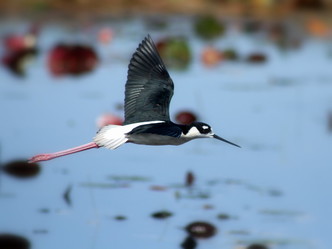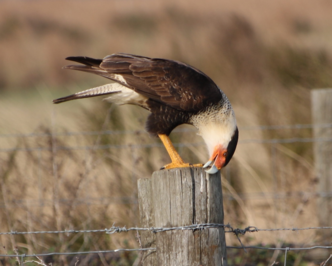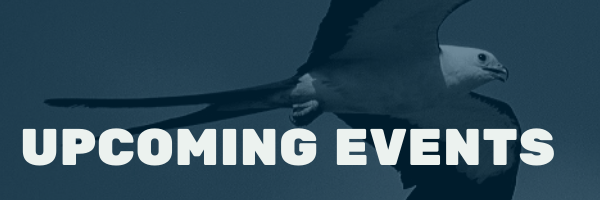 An Eastern Bluebird feeds its young at a nest box.
The end of this month has been a cold one. In north Florida, we’ve been keeping a close eye on the forecast and covering up our gardens for overnight frosts; as temperatures fell below 40 in the southern half of the sunshine state, nonnative green iguanas were tumbling out of trees. But warmer days are on the way, and with them come one of the most exciting parts of spring – nesting birds!
Different species of birds build their nests in all sorts of different places – high in the treetops, deep in thick shrubs, even hiding in plain sight on the ground. Some birds will only build their nests within the protection of some kind of hole. These cavity nesting species fall into two categories. Primary cavity nesters, such as woodpeckers, can excavate their own holes. Other species like bluebirds, chickadees, tree swallows, screech owls and kestrels are secondary cavity nesters; they also nest in cavities but must rely on naturally occurring cavities or unused old woodpecker nests.
Nesting sites are an important and finite resource that these secondary cavity nesters need to raise their young. Cavities are most often found in decayed or dead trees with softer wood, but these trees are undesirable to people and typically removed in developed areas and some timberlands. Removing these trees means there are fewer places for the birds to nest. To make matters worse, two common invasive species – European Starlings and House Sparrows – are also cavity nesters and compete for the available nesting spaces.
The good news – there is something easy (and fun!) that we as individuals can do to provide safe nest sites for these birds. Now is the time of year to put up your bird houses - also known as nest boxes. Cavity nesting species like bluebirds, wrens and chickadees are already out scouting for places to lay their eggs and raise their young.
When buying or building a nest box, you need to keep in mind several must-haves in bird real estate. Some bird houses you see at garden stores are beautiful to us, but don’t necessarily have the features that will make them appealing and safe for birds. A good box should have:
-
Ventilation – small holes, usually placed under the roof overhang, are important for airflow.
-
Drainage holes – you don’t want the box to fill with rainwater.
-
Roof – the roof should be sloped to help keep out rain and should extend over the walls of the box for extra protection.
-
No perch – predators can potentially use a perch for support. Birds do not require a perch to get in and out of the box.
-
Predator guard – adding a baffle to the pole supporting your nest box will help deter predators like snakes and raccoons.
-
Hinged door – you will need to clean out your nest box at the end of the nesting season, and a hinged door makes this much simpler. It will also enable you to easily monitor nests!
Nest boxes aren’t one-size-fits-all. Different species prefer different box shapes and sizes, different entrance hole sizes, and sometimes additions like pine wood shavings or interior ladders.
You will need to consider your landscape carefully when trying to attract a specific species. If you have forest around your house, for example, you wouldn’t want to put up a bluebird house, since these birds prefer plenty of open space. You would be better off trying to attract a wren or chickadee!
It might sound complicated to figure out what boxes are right for your yard, but luckily there are some excellent tools to help. Cornell Lab of Ornithology’s Right Bird, Right House tool will show you what birds you can potentially attract to your yard and give you detailed descriptions of species’ preferred nest boxes. If you’re handy, you can download the patterns and build your own boxes. FWC’s Planting a Refuge for Wildlife guide is also available for order online. This 40-page guide will give you detailed, Florida-specific information on nest boxes, as well as water sources, feeders, pollinator plants and more.
 Black-necked Stilt in flight. Photo by FWC.
The Black-necked Stilt, with its long red legs and flashy black-and-white plumage, is unmistakable. They have the second largest leg-to-body-size ratio of any bird, eclipsed only by the flamingo.
These birds can be spotted in the shallow waters of inland and coastal wetlands, floodplains and flooded agricultural fields. They feed on aquatic invertebrates such as diving beetles, brine shrimp, snails and the aquatic larval stages of various insects, and will also consume small frogs and fish. They can dive and swim when necessary but prefer to keep their feathers out of the water when feeding.
Black-necked Stilts lay only one clutch of 2-5 eggs per year. The male and female take turns incubating the eggs, and in hot weather will actually cool the eggs by wetting their breast feathers. The young can take their first shaky steps within hours of hatching, though their parents continue to watch over them.
In the 1800s, Black-necked Stilt populations were in decline due to their popularity as a game bird, but the passing of the Migratory Bird Act in 1914 helped to stabilize the population. The species is currently of low conservation concern, though, as with all birds, stilts are vulnerable to habitat loss, fragmentation and degradation.
The Black-necked Stilt is the species featured on our 2019 Wings Over Florida Big Year certificates – make sure you get a your certificate with this lovely artwork by applying online!
 A Crested Caracara wipes its bill at Dinner Island Ranch WMA. Photo: Travis Blunden
This month we found ourselves in south-central Florida with a few hours to spare. While there are many birding trail sites in the region, we opted to head to Dinner Island Ranch Wildlife Management Area (WMA), where we had never been. About an hour from the nearest town, this is one of the more remote birding trail sites.
With limited time, we decided that driving the main loop of improved roads was our best bet. There is no mistaking that you are in cattle country when visiting Dinner Island Ranch. As its name implies, much of the area was, and still is, a cattle ranch. The pastures and other rangelands are very open, which attracts some wonderful birds. Upon entering we were greeted immediately by American Kestrels and Eastern Meadowlarks. Then as we approached some facilities of the cattle operation, we observed a pair of Crested Caracaras on a water trough.
As we continued our driving tour, we saw quite a few more birds, including Red-shouldered Hawks, Palm Warblers, Blue-gray Gnatcatchers and Wood Storks. I’m sure if we had time for a more leisurely pace and more stops our list would have been much longer. We were surprised by an American alligator meandering down the road and, later, a raccoon family that came out to say hello. As we neared the end of the loop, we ran into a team of cowboys working up some of the many cows and calves.
Overall, despite the remoteness, Dinner Island Ranch WMA was a wonderful destination and a welcome deviation from the more crowded parts of Florida.
 Dinner Island Ranch WMA photo by Travis Blunden
Address:CR-833, Clewiston 33440
Phone: (863) 902-3349
Hours: Daily, sunrise to sunset
Trail Map
Website
 February 1 – Winter Shorebird Survey (Palm Coast)
February 1 – Prairie Pines Preserve Guided Nature Walk (North Fort Myers)
February 4, 16 – Guided Bird Walk at Anastasia State Park (St. Augustine)
February 5 – Hernando Audubon Society Birding Trip to Orlando Wetlands (Orange County)
February 6 – Hernando Audubon Society Birding Trip to Merritt Island National Wildlife Refuge (Titusville)
February 8 - Galt Preserve Guided Nature Walk (St. James City, Pine Island)
February 15 – Hernando Audubon Society Big Day Birdathon (Brooksville)
February 15 – Caloosahatchee Creeks Preserve Guided Nature Walk (North Fort Myers)
February 18 – Hernando Audubon Society Birding Trip to Werner-Boyce Salt Springs State Park (Port Richey)
February 20 – Apalachee Audubon Meeting. Moving Beyond Cardinals in Five Easy Steps: Introduction to Bird Identification (Tallahassee)
February 22 – Wild Turkey Strand Preserve Guided Nature Walk (Fort Myers)
February 26 – Pine Island Flatwoods Preserve Guided Nature Walk (St. James City, Pine Island)
February 28 – Hernando Audubon Beginning Birding (Brooksville)
Check out the events page of our website for more to do across the state!
Do you know about any other bird- or wildlife-related events going on in Florida? Help spread the word by letting us know! Send in the times, dates, locations and contacts to WildlifeViewing@MyFWC.com for posting on the Great Florida Birding and Wildlife Trail website.
Events must be related to birds or other wildlife and must be open to the public. Examples include interpretive programming, summer camps and family programs.
|